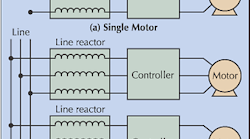Do you have problems with your existing variable-frequency drives (VFDs)? If so, 3-phase line reactors may be a very viable solution. A line reactor acts not only as a current-limiting device, but it also filters the waveform and attenuates electrical noise and transients associated with the system. You can install reactors in HVAC equipment, pumping equipment, machine tools, elevators, printing presses, UPS equipment, computer mainframes, robotics equipment, ski lifts, wind generators, electric cars, cranes, trams, and many other types of equipment, to extend the service life of the VFD and motor.
Harmonic attenuation. As the name implies, you'd typically use line reactors on the line side of a VFD, as shown in Fig. 1 at right. Harmonic compensated line reactors are specially designed to handle the waveform's harmonic content. By inserting inductive reactance into the circuit, which is a high impedance to harmonic frequencies, line reactors reduce the amount of harmonics produced by a VFD system. For harmonic reduction purposes, you typically apply 5% impedance line reactors to the input of motor drives 20 hp and higher. This reduces input harmonics to 35% total harmonic current distortion (THID) or less and minimizes the effects of harmonics on motors and other devices powered off the same electrical system.
Drive protection.
In situations where you have drives located very close to the incoming facility power source, such as a substation, they may be susceptible to any incoming spikes and other transients. This is because there may not be enough impedance (in the form of transformers, power feeders, and the like) to help counteract these transient voltage spikes. This situation can damage the front end (diode section) of the drives or cause nuisance overvoltage tripping on the system. Installing a 5% impedance line reactor at the input to each drive helps counteract line spikes, keeping them from tripping or damaging the drives.
On the other hand, if you have drives located far from the facility power source (as often seen in hospitals), they may be affected by line harmonics caused by other harmonic-generating equipment (nonlinear loads). In most applications, harmonic problems are best solved at their source. Look for large nonlinear loads, such as VFDs, and apply a 5% impedance line reactor on the input to those pieces of equipment to minimize the system harmonics.
Motor protection. A reactor that is compensated for high frequencies and protected against fast rising voltage pulses is a very effective dv/dt (rate of change of voltage with respect to time) filter, and you can use it on the load side of the drive (between the drive and motor). Fast changing pulse-width modulation (PWM) voltage pulses in PWM drives can interact with the distributed inductance and capacitance of long motor leads. This, in turn, can result in amplified peak voltages as high as 1,600V at motor terminals. In fact, the longer the cable length, the higher the peak overvoltage at the motor terminals.
This phenomenon, known as long lead effect, can stress and consequently degrade the insulation around the stator windings of motors, resulting in shorter motor life. Some have tried to compensate for the higher frequencies and harmonic currents present in the drive output waveform by oversizing the unprotected motor. A general practice is to use a 5% impedance load reactor on the load side of a VFD when the motor lead length is greater than 100 ft. Typically, you can use two 5% impedance reactors in series (10% impedance) if the motor leads exceed 1,000 ft in length.
Motor noise reduction. To reduce the audible motor noise and telephone interference factor associated with PWM drive switching rates between 1 kHz and 8 kHz, manufacturers developed VFDs with switching frequencies as high as 20 kHz. While the higher frequencies did reduce motor noise, they also aggravated PWM pulse contribution to excessive motor-shaft voltage and current that can discharge across motor bearings. VFDs that use insulated-gate bi-polar transistors (IGBTs) as high-frequency switches are most likely to cause bearing discharge current.
Where a motor, by necessity, is extremely far from its drive, you can install a high-frequency compensated reactor on the load side of the drive, either at the drive end or motor end, to help protect the motor from overvoltage, stress from PWM voltage pulses, overheating and resulting stator insulation degradation, while reducing the motor whine.
VFD protection. The load reactor also acts as a current-limiting device to protect the drive under motor short circuit conditions. Here, the line reactor slows the rate of rise of the short-circuit current and limits the current to an acceptable level.
By slowing the rate of rise of current, the reactor allows time for protection circuits in the drive to react to the short circuit and trip out safely, saving the IGBTs. The reactor also absorbs current surges created by the motor load that might otherwise cause nuisance tripping of the drive. Machine jams, multiple motor switching, and other application changes to the drive load cause motor load surges. Fig. 2 shows reactors on the load side of single and multiple motors.
Looking at the load side reactor from the motor view, the ability of the reactor to filter the waveform produced by the VFD improves the performance of both the motor and the total system.
Summary of possible reactor performance. The installation of load reactors with drives and motors can reduce the high-frequency currents in the motor and protect the motor from long lead effects. Basically, the reactor attempts to recreate a sine wave, thus improving overall system performance, reliability, and efficiency. It may reduce audible motor noise by as much as 3 dB to 5 dB. Tests have shown motor temperatures can drop as much as 20°C (more than double the motor life) when using a harmonic-compensated 5% impedance load reactor.
On the line side, reactors stabilize the current waveform, which reduces harmonic distortion and the burden on upstream electrical equipment. By absorbing line spikes and filling some sags they can prevent overvoltage and undervoltage tripping problems. For example, when the utility switches power factor correction capacitors on the electrical power grid, it creates voltage spikes. The impedance of the reactor in the input circuit helps prevent these voltage spikes and virtually eliminates nuisance tripping of drives due to overvoltage.
A line reactor can also filter out pulsed and notched distortion, which can minimize interference with other electronic equipment like computers, PLCs, telecommunications systems, instrumentation, and other VFDs.
The use of line and load reactors increases the reliability, performance, and efficiency of VFD systems, extends the life of both drives and motors, and reduces the amount of energy consumed by the motor/drive system.
Houdek is VP of marketing and sales with MTE Corp., Menomonee Falls, Wis.





